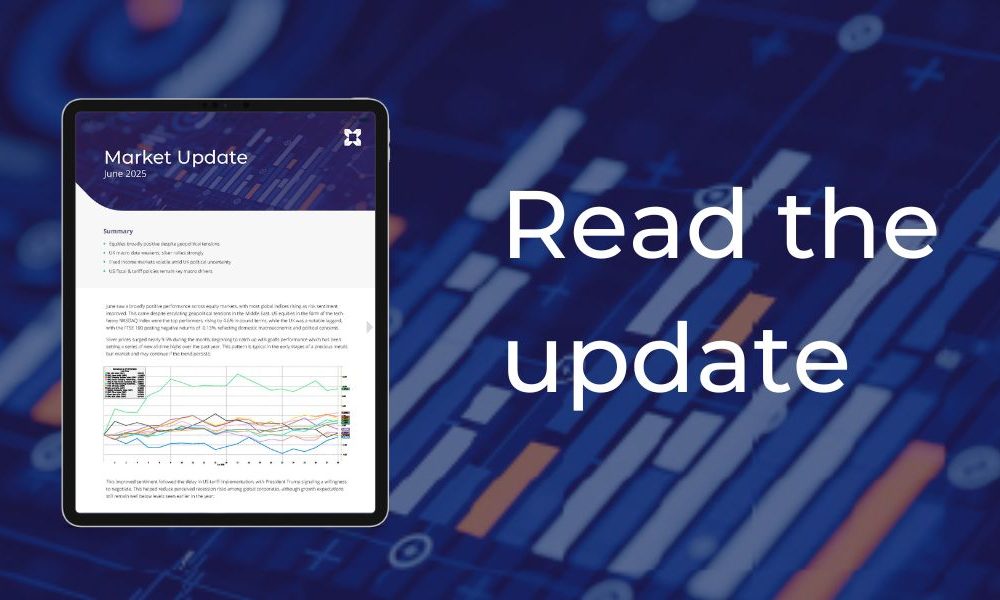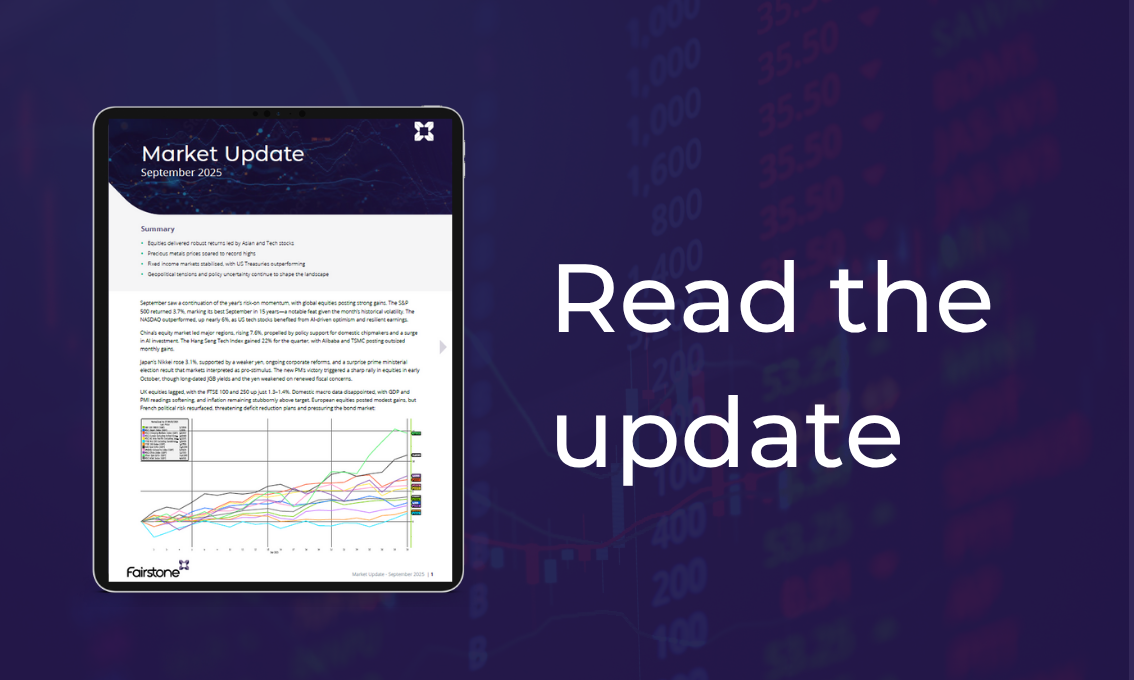
Market Updates

September saw a continuation of the year’s risk-on momentum, with global equities posting strong gains. The S&P 500 returned 3.7%, marking its best September in 15 years—a notable feat given the month’s historical volatility. The NASDAQ outperformed, up nearly 6%, as US tech stocks benefited from AI-driven optimism and resilient earnings.
China’s equity market led major regions, rising 7.6%, propelled by policy support for domestic chipmakers and a surge in AI investment. The Hang Seng Tech Index gained 22% for the quarter, with Alibaba and TSMC posting outsized monthly gains.
Japan’s Nikkei rose 3.1%, supported by a weaker yen, ongoing corporate reforms, and a surprise prime ministerial election result that markets interpreted as pro-stimulus. The new PM’s victory triggered a sharp rally in equities in early October, though long-dated JGB yields and the yen weakened on renewed fiscal concerns.
UK equities lagged, with the FTSE 100 and 250 up just 1.3–1.4%. Domestic macro data disappointed, with GDP and PMI readings softening, and inflation remaining stubbornly above target. European equities posted modest gains, but French political risk resurfaced, threatening deficit reduction plans and pressuring the bond market:
Precious metals were the standout asset class. Gold surged 11% in GBP terms, trading near $3,900/oz—a new all-time high. Silver rallied 14.6%, approaching its 2011 peak of $50/oz. The rally was driven by a confluence of factors: lower real yields, a weaker US dollar, persistent inflation, and heightened geopolitical risk. Central banks, notably China, continued to accumulate bullion, while private investors poured record inflows into gold-backed ETFs:
The technical picture for gold and silver is stretched, with prices having doubled in less than two years. While the medium-term outlook remains constructive, near-term consolidation is possible given the speed and magnitude of recent gains.
Bond markets stabilised in September, with US Treasuries up 1% as the Fed delivered a dovish rate cut. Investment grade corporate bonds outperformed; particularly those US denominated, benefiting from spread compression, while high yield lagged slightly as spreads widened modestly.
Long-dated government bond yields remained below August highs, but the UK’s 30-year Gilt yield reached 5.6%, its highest since the late 1990s, underscoring persistent worries about fiscal sustainability.
The main macroeconomic headline in September was the Federal Reserve’s pivot to monetary easing; cutting rates by 25bps and signalling scope for further cuts this year. The decision was framed as risk-management, with downside risks to employment outweighing inflation concerns. The ECB and BoE held rates, maintaining a cautious tone and emphasising data dependence. The Bank of Japan stood pat but delivered a hawkish message, only to see expectations upended by the election result.
US fiscal and tariff policies remained central to the macro narrative. The trade-weighted tariff rate now exceeds 18%, reminiscent of 1930s levels, but actual duties paid are still catching up. The growth and price impacts of tariffs are likely to intensify in coming quarters, with baseline US growth expectations remaining resilient for now.
The US federal government shutdown began on October 1, with major services shuttered and workers furloughed. The primary dispute centres on healthcare spending. While shutdowns are not uncommon, the current episode is notable for its potential duration and the administration’s threat of permanent layoffs in federal departments. Per Oxford Economics’ analysis, each week of shutdown is estimated to reduce annualised GDP growth by 0.1–0.2 percentage points, or up to $15bn per week. The longer the shutdown persists, the greater the risk to government-funded programmes and investor sentiment.
Markets have largely looked through the headline risk so far, focusing on the rate path and incoming data, though delays in key economic releases (e.g., jobs and inflation) could increase uncertainty.
The overall environment remains moderately supportive for risk assets, with steady growth, stable (if elevated) inflation, and central banks signalling further easing. However, uncertainty is elevated, and policy decisions will remain data-dependent.
Careful monitoring of economic indicators, policy signals, and geopolitical developments will be essential in the months ahead. While conditions remain broadly constructive, prudent risk management and portfolio diversification are warranted.
Overall, September 2025 reinforced the importance of agility and vigilance in portfolio management. While markets have shown resilience, the interplay of monetary policy, fiscal dynamics, and geopolitical risk continues to drive volatility and opportunity. We remain constructive but cautious, favouring quality, diversification, and active risk management as the global landscape evolves.
For a more detailed look at this month’s update, listen to our Market Update podcast. Join Portfolio Manager Imogen Hambly and Investment Director Oliver Stone as they break down the key market developments shaping September.
We have over 1250 local advisers & staff specialising in investment advice all the way through to retirement planning. Provide some basic details through our quick and easy to use online tool, and we’ll provide you with the perfect match.
Alternatively, sign up to our newsletter to stay up to date with our latest news and expert insights.
| Match me to an adviser | Our advisers |
The value of investments may fluctuate in price or value and you may get back less than the amount originally invested. Past performance is not a guide to the future. The views expressed in this publication represent those of the author and do not constitute financial advice.